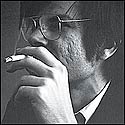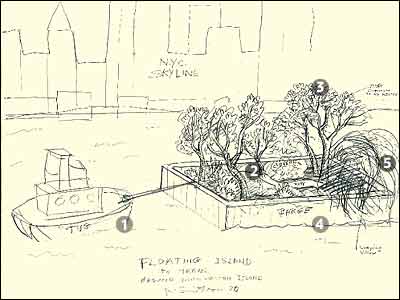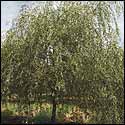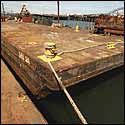
New Yorkers enjoy the unexpected gesture, the extravagant folly, the existential leap. This fall, Minetta Brook (a nonprofit arts organization) and the Whitney Museum will realize a whimsical idea of this kind by the earthworks artist Robert Smithson. In a drawing made in 1970, three years before his death, Smithson conjured up a “floating island” that would circle the fixed island of Manhattan like a slow-moving planet. Built on a barge and pulled by a tugboat, it consisted of a tailored landscape of rocks, trees, and pathways. It looked like something carved from Central Park.
Under the supervision of Smithson’s artist wife, Nancy Holt, Floating Island to Travel Around Manhattan Island is now being assembled aboard a 30-by-90-foot barge. It’s scheduled to set forth from September 17 to 25, and will complement the artist’s retrospective at the Whitney. Smithson is usually associated with a primordial view of nature, but he was also a Manhattanite who revered Frederick Law Olmsted, the designer of Central Park—an island garden within a concrete city. By floating a piece of parkland around Manhattan, Smithson, who liked to bring nature into the museum and the museum into nature, carried out a characteristic reversal. Suddenly, the park has escaped from its cultural moorings and is encircling Manhattan. Nature now observes the city even as the city observes nature. (Manhattan becomes the more confined place.) While less famous than The Gates, another theatrical piece concerning Central Park staged many years after it was conceived, Floating Island is the more provocative work. It calls to mind voyages of discovery and loss, beginning with the Ark itself, which also put nature into a boat. It seems both romantic and despairing. On the one hand, the natural world gets chopped up yet again; no union with the Earth seems possible. On the other hand, the island, which is also a Floating Garden, becomes a distant object of Edenic desire. Does that sound too religious for New Yorkers? Well, there’s also something wry and ironic about Floating Island that suits the city. Think about it: A tugboat’s gotta tow paradise.


Rocks and Trees
This weeping willow- chosen for its resemblance to the one in Smithson’s sketch- and six other specimen trees came from the Rappleyea Nursery, in Allentown, New Jersey. The Manhattan-schist boulders are from Central Park, near the composting area at 103rd Street and the East Drive, and they’ll go back once the project’s done.

The Tugboat
It took a while to find a small tug with the right proportions and a nearby home port, but the design team eventually located an accommodating company— appropriately called Island Towing— and rented the Rachel Marie, captained by Bob Henry. It’ll be repainted red, to evoke the classic New York Harbor tug.

The Barge
Few barges are in the harbor right now—it’s the busiest time of the year—so Minetta Brook had to book Sterling Equipment’s 30-by-90-footer starting in July. Says Minetta Brook’s director Diane Shamash, “Barge yards are dedicated to getting the job done fast, so taking a yard over for ten days to buildsomething is unheard of.”
Floating Island
By Robert Smithson, organized by the Whitney Museum and Minetta Brook
September 17 through 25.
Robert Smithson
Whitney Museum; through October 23.